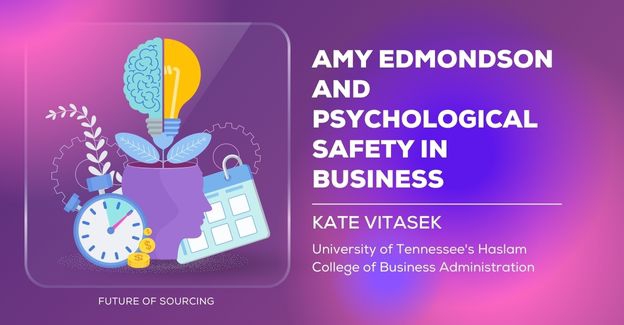In this article, Kate Vitasek, faculty member of the University of Tennessee’s Haslam College of Business Administration, shares her views on Amy C. Edmondson's work on psychological safety. The major takeaway is that leaders should encourage teams to speak their minds. Why? Giving people permission to be candid and respectful is a good way to spur innovation, because when people feel safe, good things happen. And that's good for business.
People and businesses need to feel safe, both physically and psychologically. In this area, Amy C. Edmondson is doing important work in the realm of psychological safety.
Edmondson is the Novartis Professor of Leadership and Management at the Harvard Business School, a chair established to “support the study of human interactions that lead to the creation of successful enterprises that contribute to the betterment of society.”
She is the author of The Fearless Organization: Creating Psychological Safety in the Workplace for Learning, Innovation and Growth. The key to innovation, according to Edmondson, is the ability to attract and retain quality talent, "but what good does this talent do if no one is able to speak their mind?”
In her own words, she defines psychological safety as a “belief that the workplace is safe for speaking up, with ideas, questions, concerns and even mistakes. It's a sense of confidence that your voice is valued.”
Briefly put, it’s permission for candor, that the workplace is somewhere to count on all voices being heard “because you never know when you will have had the observation that someone else missed that will be mission critical.”
A key word from the book title is “fearless.” This is not about being “nice,” in fact psychological safety embraces both nice and not-so-nice ideas in order to get to the truth about operations, conflicts and innovation.
The Goal: Excellence
The lesson for organizations is to instill an atmosphere and environment of trust that embraces all points of view. It’s okay to have different viewpoints, as long as they are not critically toxic. She notes:
“Psychological safety in a psychologically safe workplace doesn't mean that all of your ideas will be applauded. It's certainly not permission to slack off, it's not a license to whine, it's not oversharing – we still want people to be thoughtful and considerate in sharing work-relevant content.”
Psychological safety isn't necessarily an organizational goal. It’s an aspect and means to attaining the goal, which is excellence. And the road is often bumpy. To navigate the journey, Edmondson provides some tips that provide a clear path forward to continuous learning and healthy innovation:
- Explore the link between psychological safety and high performance
- Create a culture where it’s “safe” to express ideas, ask questions and admit mistakes
- Nurture the level of engagement and candor required in today’s knowledge economy
- Follow a framework for establishing psychological safety in your team or organization
- Abandon the “yes-man” approach to encourage creativity, clarify goals, achieve accountability and redefine leadership
In another book, Extreme Teaming, written with Jean-François Harvey, Edmondson explores the rise of collaboration by teams of experts operating across different professions, organizations and industries. The book has insights into the world of complex, cross-industry projects and the ways they must be managed.
In a third book, Teaming, Edmondson says organizations thrive, or fail to thrive, based on how well the small groups within those organizations work. In most organizations, the work that produces value for customers is carried out by teams, and increasingly, by flexible team-like entities. “The pace of change and the fluidity of most work structures means that it's not really about creating effective teams anymore, but instead about leading effective teaming. Teaming shows that organizations learn when the flexible, fluid collaborations they encompass are able to learn.”
My favorite part of the book? Edmondson identifies the factors that prevent organizations from teaming and learning together effectively, such as interpersonal fear, irrational beliefs about failure, groupthink, problematic power dynamics and information hoarding. In my work on complex outsourcing relationships, I definitely see these factors getting in the way of success.
The Bottom Line
Psychology safety means creating an environment for interpersonal risk-taking and ensuring team members have confidence their voice is valued. This demands organizations create a culture where team members will not be punished or humiliated for speaking up with ideas, questions, concerns or mistakes.
I applaud Edmondson for speaking up about the value of speaking up.



